Vishalgad Fort: Best for History, Architecture, & Travel Guide to the Maratha Stronghold
- Location: Kolhapur
- Entry Fee: FREE
- Timings: Open all year round; best to visit between 6:00 AM – 6:00 PM
- Categories: Forts, Historical Place, Tourist Places
- Tags: Forts near Kolhapur, Kolhapur Tourism, Maratha heritage sites, Maratha History, Sahyadri trekking destinations, Shivaji Maharaj, Shivaji Maharaj forts, Vishalgad Fort, Vishalgad Fort history
- Location Taxonomy: India, Kolhapur, Maharashtra
Nestled in the Sahyadri ranges of Maharashtra, Vishalgad Fort is a majestic hill fort that echoes the valor of the Maratha Empire. Also known as Khelna Fort, it played a pivotal role in the military campaigns of Chhatrapati Shivaji Maharaj and served as a strategic outpost during the 17th century. With its panoramic views, historical ruins, and spiritual shrines, Vishalgad is a must-visit destination for history lovers, trekkers, and cultural explorers.
This article explores the complete history, architecture, trekking experience, nearby attractions, and FAQs about Vishalgad Fort, making it a comprehensive guide for travelers and heritage enthusiasts. You can read : Ajinkyatara Fort: Famous Unconquerable Star of Satara
Historical Significance of Vishalgad Fort
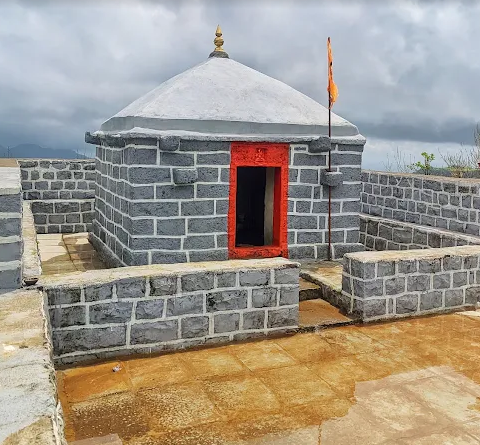
- Original Name: Khelna Fort
- Renamed By: Chhatrapati Shivaji Maharaj as “Vishalgad,” meaning “Grand Fort”
- Strategic Role: Served as a key military base and refuge during Maratha campaigns
- Famous Escape: Shivaji Maharaj’s daring escape from Siddi Johar’s siege at Panhala and his arrival at Vishalgad in 1660 is legendary
- Maratha Era: Became a stronghold for Maratha forces and a center for regional administration
The fort’s history is deeply intertwined with the rise of the Maratha Empire and the legacy of Shivaji Maharaj’s guerrilla warfare tactics.
Architectural Features of Vishalgad Fort
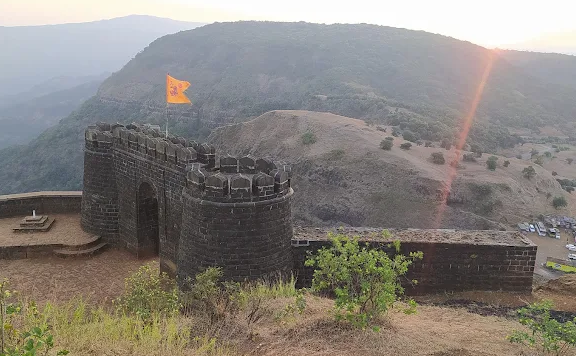
Though much of the fort is in ruins today, its layout and surviving structures reflect its former grandeur.
Key Highlights:
- Fort Walls and Bastions: Massive stone ramparts built to withstand sieges
- Amruteshwar Temple: A historic Shiva temple still visited by devotees
- Takmak Tok: A cliff used for executions during the Maratha era
- Sati’s Vrindavan: A memorial site with spiritual significance
- Water Tanks and Cisterns: Ancient rock-cut reservoirs that supplied water to the fort
- Watchtowers: Provided surveillance over the surrounding valleys
The fort’s architecture combines military utility with spiritual sanctity, making it unique among Sahyadri forts.
Trekking Experience at Vishalgad Fort
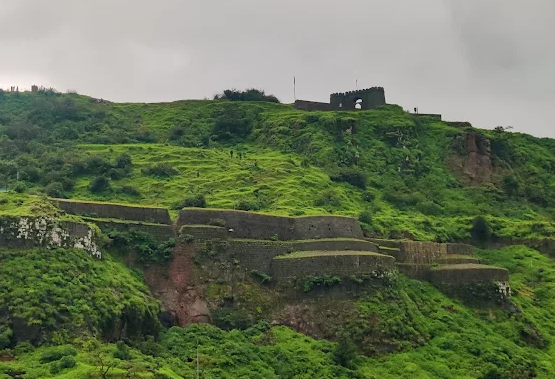
Trekking to Vishalgad Fort is a rewarding experience for nature lovers and adventure seekers.
Trekking Route:
- Base Village: Shirgaon or Gajapur
- Altitude: Approx. 3,500 feet (1,067 meters)
- Duration: 2–3 hours to ascend, depending on the route
- Difficulty Level: Easy to moderate
- Best Season: Monsoon (July–September) for lush greenery, and winter (October–February) for clear skies
Highlights of the Trek:
- Forest trails with rich biodiversity
- Historical ruins and temples en route
- Scenic viewpoints overlooking the Konkan region
- Local guides sharing stories of Shivaji’s escape
- Peaceful atmosphere ideal for meditation and photography
Natural Beauty and Biodiversity
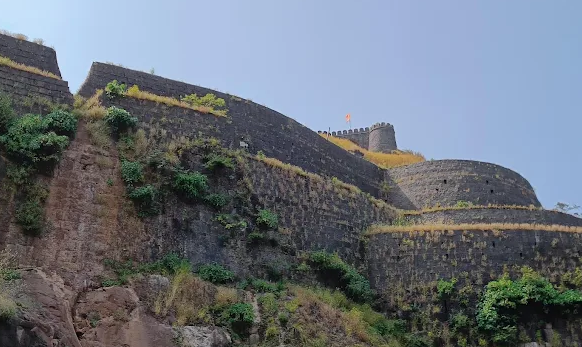
- Flora: Wildflowers, medicinal herbs, and dense forests
- Fauna: Monkeys, peacocks, and native bird species
- Birdwatching: Ideal during early mornings and post-monsoon season
- Sunrise Views: The fort offers spectacular sunrise vistas over the Sahyadris
Location and Accessibility
- District: Kolhapur, Maharashtra
- Nearest Town: Panhala (18 km), Kolhapur (76 km)
- Nearest Railway Station: Kolhapur Railway Station
- Nearest Airport: Kolhapur Airport (80 km)
How to Reach:
- From Mumbai: 400 km (approx. 8 hours by road)
- From Pune: 250 km (approx. 6 hours by road)
- Local buses and jeeps available from Panhala and Kolhapur
Best Time to Visit Vishalgad Fort
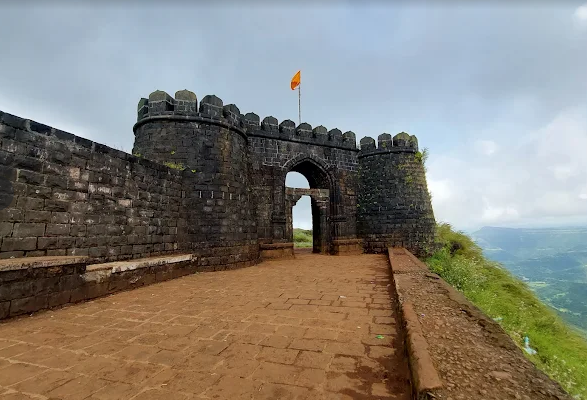
- Monsoon (July–September): Waterfalls and greenery
- Winter (October–February): Pleasant weather for trekking and sightseeing
- Avoid Summer (March–June): Hot and dry conditions
Entry Fees and Timings
- Entry Fee: Free
- Timings: Open all year round; best to visit between 6:00 AM – 6:00 PM
- Guides: Local guides available at base villages
Things to See at Vishalgad Fort (List View)
- Amruteshwar Temple
- Fort Walls and Bastions
- Takmak Tok
- Sati’s Vrindavan
- Water Tanks and Cisterns
- Watchtowers
- Shivaji Maharaj Escape Route Memorial
- Forest Trails
- Sunrise Viewpoints
- Local Villages and Cultural Sites
Nearby Tourist Attractions
- Panhala Fort (18 km): Historic fort with links to Shivaji Maharaj
- Jyotiba Temple (30 km): Popular pilgrimage site
- Rankala Lake (75 km): Scenic lake in Kolhapur
- Mahalaxmi Temple, Kolhapur (76 km): One of the Shakti Peethas
- Gaganbawda (40 km): Hill station with panoramic views
Travel Tips for Visitors
- Wear trekking shoes with good grip
- Carry water, snacks, and a raincoat during monsoon
- Start early to avoid afternoon heat
- Respect local traditions and avoid littering
- Hire a guide to understand the fort’s history better
❓ FAQs about Vishalgad Fort
Q1: Why is Vishalgad Fort famous?
A: It is known for Shivaji Maharaj’s legendary escape and its strategic importance during the Maratha era.
Q2: What is the best time to visit Vishalgad Fort?
A: October to February is ideal for trekking and sightseeing.
Q3: How far is Vishalgad Fort from Kolhapur?
A: Approximately 76 km, around 2 hours by road.
Q4: Are there temples at Vishalgad Fort?
A: Yes, the Amruteshwar Temple is a major spiritual site on the fort.
Q5: Is Vishalgad Fort suitable for beginners?
A: Yes, the trek is easy to moderate and suitable for most fitness levels.
Conclusion
Vishalgad Fort is a timeless symbol of Maratha valor, spiritual devotion, and natural beauty. From its role in Shivaji Maharaj’s military campaigns to its serene temples and scenic trails, the fort offers a rich experience for every visitor. Whether you’re a history buff, a trekker, or a spiritual seeker, a visit to Vishalgad promises inspiration, adventure, and a deeper connection to Maharashtra’s glorious past.
